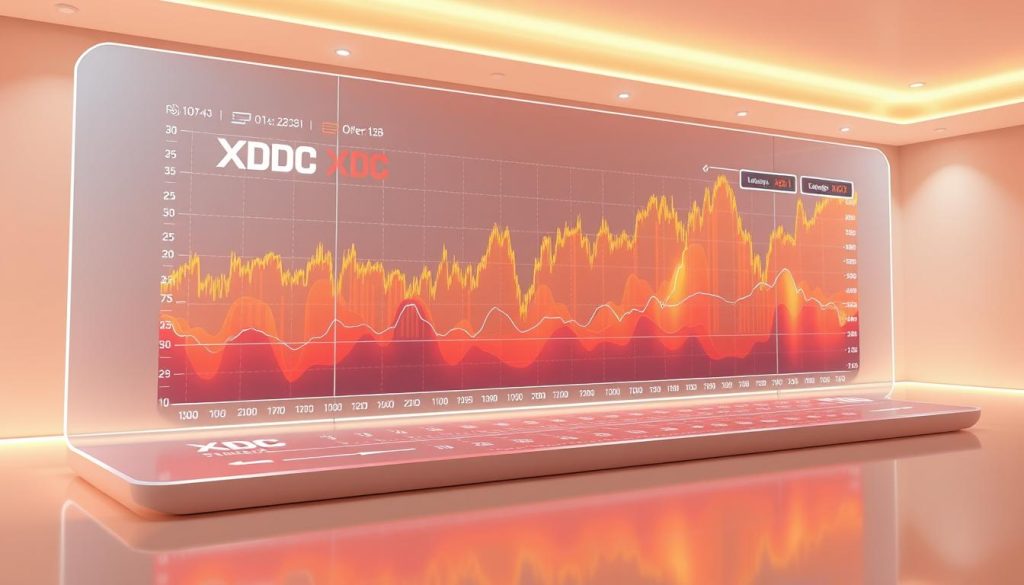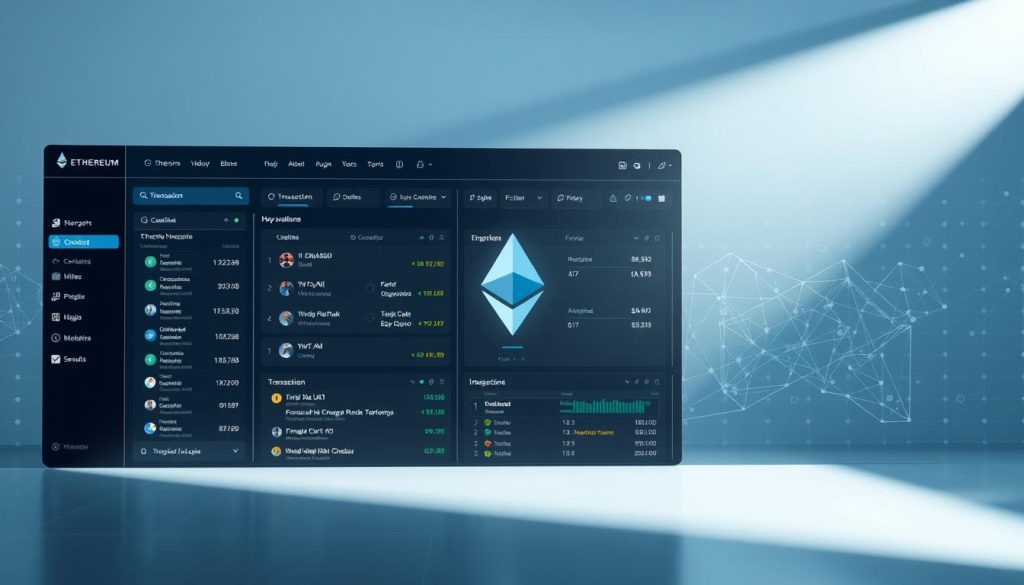Bitcoin’s mining difficulty has skyrocketed by over 50 trillion percent since 2009. Your friend’s old laptop? It would now need 10 million years to mine one Bitcoin.
I’ve explored today’s cryptocurrency mining landscape for six months. The real question is whether mining makes economic sense for individuals like us.
The mining world has changed dramatically. We now see industrial-scale operations and specialized ASIC hardware. Complex calculations have become the norm.
Surprisingly, individual miners still have a chance. Opportunities exist, but they require a different approach than before.
This guide covers bitcoin mining profitability in 2025. We’ll look at real data and current scenarios. I’ll share tools and strategies that work in today’s competitive environment.
Key Takeaways
- Mining difficulty has increased exponentially, making home mining extremely challenging
- Specialized ASIC hardware is now essential for competitive mining operations
- Electricity costs are the primary factor determining mining profitability
- Pool mining offers better chances for individual miners than solo mining
- Alternative cryptocurrencies may provide better opportunities for small-scale miners
- Initial investment costs have risen significantly compared to Bitcoin’s early days
Understanding Bitcoin Mining Today
Bitcoin mining is more complex than the “digital gold rush” story suggests. It’s a sophisticated economic system that keeps the entire Bitcoin network running. The process has become highly competitive and technical.
Mining involves specialized computers competing to validate transactions and add them to the blockchain. Miners act as digital accountants, racing to solve complex math problems. The winner adds the next block and receives newly created Bitcoin.
What is Bitcoin Mining?
The Bitcoin system has fascinating features. The network adjusts puzzle difficulty every 2,016 blocks. Blocks are found every 10 minutes on average. The current reward is 3.125 BTC, which halved in April 2024.
The bitcoin mining difficulty adjustment occurs roughly every two weeks. More miners make puzzles harder, fewer miners make them easier. This process works like a thermostat, keeping the network stable.
The Importance of Mining in the Bitcoin Ecosystem
Mining serves two critical functions: securing the network against attacks and introducing new Bitcoin into circulation. Without miners, Bitcoin wouldn’t work. The economic incentives ensure miners will always secure the network.
Each added block increases the security of previous transactions. After six confirmations, a Bitcoin transaction becomes practically irreversible. Bitcoin mining rewards exist to encourage people to maintain this security.
The economic model is simple yet elegant. Miners invest in equipment and electricity. They compete to solve puzzles. Winners receive Bitcoin rewards. The network becomes more secure with each block.
As bitcoin mining difficulty increases, the network grows stronger. This balance of security, decentralization, and economic incentives has sustained Bitcoin for over 15 years.
Current State of Bitcoin Mining in the U.S.
America’s Bitcoin mining scene changed drastically after China’s 2021 ban. The U.S. quickly became the world’s mining leader. American entrepreneurs swiftly filled the gap in global hash rate.
The United States now controls about 38% of the world’s Bitcoin hash rate. This is a complete flip from four years ago. I’ve visited several operations across the country, and they’re truly impressive.
These aren’t small setups with a single bitcoin mining rig in someone’s garage. We’re talking about massive facilities housing thousands of specialized computers working non-stop.
Mining Locations and Their Energy Sources
Texas leads in Bitcoin mining operations for good reasons. The state’s open energy market allows miners to deal directly with power providers. Texas also has plenty of renewable energy resources that mining companies use.
I’ve seen Texas facilities powered entirely by solar and wind energy. It makes financial sense as renewable energy costs have dropped. Miners often get good long-term contracts.
Wyoming attracts miners with crypto-friendly rules and cheap coal power. Many Wyoming operations are switching to cleaner energy as costs fall. North Dakota uses stranded natural gas that would otherwise go to waste.
| State | Primary Energy Source | Key Advantage | Regulatory Environment |
|---|---|---|---|
| Texas | Solar, Wind, Natural Gas | Deregulated energy market | Business-friendly |
| Wyoming | Coal, Wind | Low energy costs | Crypto-friendly laws |
| North Dakota | Stranded natural gas | Waste energy utilization | Supportive policies |
| Washington | Hydroelectric | Clean, cheap power | Mixed regulations |
Major Mining Operators in the Country
Marathon Digital Holdings is one of the largest public mining companies in the U.S. They’ve built huge facilities across Texas, focusing on renewable energy. Their approach to bitcoin mining hardware is unique, often dealing directly with manufacturers.
Riot Platforms is another big player in the field. Their Texas operations have advanced cooling and power systems. They’ve invested heavily in infrastructure to handle the heat from thousands of mining machines.
These big operators stand out because of their hardware strategy. They have direct ties to manufacturers like Bitmain and MicroBT. This gives them better prices and first access to new hardware.
The hardware in these operations is top-notch. Most use Antminer S19 XP and Whatsminer M50S units. Each machine can do over 140 terahashes per second – that’s powerful computing.
During facility tours, I was amazed by the scale. Imagine warehouse-sized buildings full of mining equipment. The noise is intense, and cooling needs are huge. Each facility needs complex power systems.
Smaller regional operators are also important. Companies like Compass Mining host for individual miners. This lets people mine without building their own setups. It opens doors for those who can’t afford massive bitcoin mining rig setups.
Market Trends for Bitcoin Mining
Bitcoin mining has seen its most turbulent period in history. The data reveals a story that’s both sobering and encouraging. Your perspective and operational efficiency determine your outlook.
Since 2020, the mining landscape has changed dramatically. The gold rush mentality evolved into a sophisticated business. Every serious miner now relies on a bitcoin mining calculator to determine profitability before investing.
Recent Statistics on Mining Profitability
Current metrics show stark differences between efficient and struggling operations. Miners with electricity costs below $0.06 per kWh maintain healthy profits. Those paying above $0.10 per kWh face significant challenges.
The April 2024 halving event created an interesting paradox. Many predicted widespread mining shutdowns, but the opposite occurred. Efficient operations saw improved profitability as weaker competitors left the network.
| Operation Size | Electricity Cost | Current Profitability | Break-even Timeline |
|---|---|---|---|
| Small Scale (1-10 ASICs) | $0.08/kWh | 15-25% | 18-24 months |
| Medium Scale (100+ ASICs) | $0.05/kWh | 35-45% | 12-16 months |
| Industrial Scale (1000+ ASICs) | $0.03/kWh | 60-80% | 8-12 months |
Bitcoin mining cloud services offer an alternative for those without cheap electricity access. However, my experience suggests caution when evaluating these platforms.
Graph: Bitcoin Mining Profitability Over the Last Five Years
The five-year profitability trend looks like a roller coaster. In 2021, during Bitcoin’s peak, miners enjoyed returns of 300-400% annually. Those were the days when any bitcoin mining calculator showed green across the board.
China’s mining ban in mid-2021 triggered an 80% profitability drop overnight. The network difficulty plummeted, but so did Bitcoin’s price. This created a complex recovery period.
By late 2023, we saw a fascinating market correction. Inefficient miners had left, and network difficulty stabilized. Bitcoin’s price found new support levels. This created opportunities for well-positioned operations.
Mining profitability now correlates more closely with Bitcoin’s price than network difficulty. This represents a fundamental shift from earlier years. Previously, difficulty adjustments were the primary profitability driver.
The trend data shows bitcoin mining cloud providers often struggle during volatile periods. Their fixed contracts can’t adapt to changing market conditions. Many legitimate cloud mining services have shifted to more flexible pricing models.
Technological Advances Impacting Mining
Innovation drives modern Bitcoin mining, from chips to software. The technological leap in recent years has been incredible. Miners once celebrated basic efficiency improvements.
Today’s mining operations rely on sophisticated technology stacks. These systems were unimaginable a decade ago. Advanced hardware and intelligent software create mining systems that adapt and optimize.
New Mining Hardware for Enhanced Efficiency
Bitcoin mining hardware has evolved dramatically. The Antminer S9 was once cutting-edge at 13.5 TH/s. Now, the Antminer S21 pushes 200 TH/s with better power efficiency.
J/TH (joules per terahash) is the key metric. It measures energy consumption per unit of mining power. Modern miners achieve 15-20 J/TH compared to 100+ J/TH from older models.
This efficiency boost directly impacts profitability. Lower energy use per hash means higher profit margins. This is especially true when electricity costs remain constant.
Software Innovations in Mining Operations
Bitcoin mining software has seen remarkable innovation. CGMiner and BFGMiner now support advanced features. These include dynamic frequency scaling, temperature monitoring, and automatic failover.
Management platforms like Awesome Miner and Hive OS are exciting developments. They allow remote monitoring of hundreds of machines. These tools provide real-time profitability calculations and predictive maintenance alerts.
Some operations use AI-driven optimization for mining parameters. This intelligent approach to Bitcoin mining represents the industry’s future. It adjusts based on electricity prices, network difficulty, and weather conditions.
Renewable energy integration has driven software innovation. Systems adjust mining based on solar production and grid demand. This smart energy management reduces costs and supports grid stability.
Modern bitcoin mining software offers sophisticated analytics dashboards. These tools help track performance metrics and identify optimization opportunities. Miners can make data-driven decisions about their operations.
Environmental Impact of Bitcoin Mining
Bitcoin’s environmental impact sparks heated debates. The network’s energy use is staggering, yet the source matters more than the amount. Let’s explore the nuances of this complex issue.
Bitcoin consumes about 150 terawatt-hours yearly. That’s similar to Argentina’s electricity use. However, the energy source significantly affects its environmental impact.
Electricity Consumption and Carbon Footprint
Mining operations run non-stop, straining local power grids. Their carbon footprint varies widely based on location. Energy sources play a crucial role in emissions.
Texas miners often use wind energy. New York operations tap into hydroelectric power. The energy mix greatly influences the environmental impact.
Carbon intensity differs by region:
| Region | Primary Energy Source | Carbon Intensity (kg CO2/MWh) | Mining Operations |
|---|---|---|---|
| Pacific Northwest | Hydroelectric | 45 | High concentration |
| Texas | Wind/Natural Gas Mix | 385 | Rapidly growing |
| Wyoming | Coal | 865 | Declining presence |
| California | Solar/Natural Gas | 295 | Limited operations |
Sustainable Mining Practices
Sustainable practices are becoming an economic necessity. Renewable energy is often the cheapest option for large-scale operations. Long-term contracts make clean energy even more attractive.
Some facilities use innovative approaches. Crusoe Energy powers mining with stranded natural gas. This reduces methane emissions while generating useful work.
Renewable energy use in Bitcoin mining has grown rapidly. It jumped from 25% in 2020 to over 50% in 2025. This shift reflects both environmental awareness and economic sense.
Miners sometimes get paid to use excess renewable energy. They provide flexible load, helping stabilize renewable energy systems. This symbiosis benefits both industries.
Some mining companies partner with renewable energy projects. They offer guaranteed demand, helping finance new solar and wind installations. This relationship advances clean energy development.
Modern mining facilities also recover waste heat. Some heat greenhouses or provide district heating. These practices improve overall energy efficiency.
Immersion cooling systems boost efficiency further. They cut energy use by 10-20% compared to air cooling. These systems also allow for denser installations.
Bitcoin mining’s environmental impact remains a hot topic. Energy use is still high, but cleaner sources are gaining ground. This trend points to a more sustainable future for the industry.
Future Predictions for Bitcoin Mining
Bitcoin mining is changing fast. Big mining pools now control most of the network’s power. This shift is changing how we see mining’s future.
Small miners are finding it harder to compete. Large operations with cheap energy and top hardware dominate. Mining pools are now key for smaller miners to stay profitable.
Experts’ Outlook for 2025
Industry experts predict more consolidation and tech advances. Big bitcoin mining pools like Foundry USA, AntPool, and F2Pool now control over 60% of the network.
This brings stability but raises concerns. These pools are more efficient, but it questions Bitcoin’s decentralized nature.
Hardware makers are pushing for better efficiency. New chips could be 30-40% more efficient than current ones.
But we’re nearing the limits of silicon chips. Future gains will come from better cooling and renewable energy use.
Factors That Could Influence Bitcoin Mining’s Viability
Energy costs remain the main factor in mining profits. Areas with cheap, renewable energy are becoming mining hotspots.
Regulations pose risks and opportunities. Some U.S. states are already setting stricter rules for mining operations.
Bitcoin mining pools will be more important as mining gets harder. They offer steady payouts, but fees and centralization are concerns.
Bitcoin’s growing adoption supports higher prices. This helps offset increasing difficulty and decreasing block rewards.
| Factor | Current Impact | 2025 Prediction | Influence on Mining |
|---|---|---|---|
| Mining Pool Concentration | 60% controlled by top pools | 70% concentration expected | Increased efficiency, centralization concerns |
| Hardware Efficiency | 3nm chips emerging | 2nm chips, cooling innovations | 30-40% efficiency gains possible |
| Energy Regulations | State-level restrictions | Federal oversight likely | Higher compliance costs, renewable shift |
| Bitcoin Price Support | Institutional adoption growing | Mainstream acceptance | Higher prices offset mining challenges |
The bitcoin mining pools market will likely see more consolidation. Smaller pools may struggle to keep up with larger ones.
Green mining practices are on the rise. Solar and wind-powered operations are becoming more common. Some miners are teaming up with renewable energy companies.
Bitcoin halving events will keep testing mining profits. Only the most efficient operations will survive. This favors big miners and established pools.
Mining is becoming more professional. Home mining is no longer profitable. Success now depends on cheap energy, good hardware, and joining solid mining pools.
Tools and Resources for Aspiring Miners
Bitcoin mining success depends on choosing the right tools. Most beginners fail due to poor tool selection or cost misunderstanding. The mining landscape has changed, requiring modern solutions for current market conditions.
Best Mining Software Platforms
Three mining software platforms stand out for different skill levels and goals. NiceHash is ideal for beginners, handling technical complexities automatically. It optimizes hardware for maximum profitability but charges higher fees.
CGMiner is perfect for experienced miners. It offers incredible flexibility and optimization options. However, it requires technical knowledge and patience to set up properly.
Awesome Miner excels at managing multiple rigs. It provides centralized monitoring and profit switching across cryptocurrencies. The dashboard displays real-time metrics and switches to the most profitable coins automatically.
Recommended Hardware for Miners
ASIC miners are essential for Bitcoin mining today. GPU mining is no longer viable. Top hardware options include the Antminer S21 series, Whatsminer M60S, and Antminer S19 XP.
A single S21 costs $3,000-4,000 and uses 3,500W of power. This is equivalent to running three electric ovens continuously. Your electricity costs will increase significantly.
- Antminer S21 series – Excellent efficiency and reliability
- Whatsminer M60S – Strong performance with competitive power consumption
- Antminer S19 XP – Proven track record for large operations
For profit calculations, I use WhatToMine and CoinWarz. These tools consider current bitcoin mining difficulty, electricity costs, and hardware efficiency. They provide realistic projections, unlike overly optimistic calculators from hardware sellers.
The bitcoin mining difficulty has risen to over 60 trillion. This is a massive increase from 1 trillion in 2017. More hash power is needed to earn the same rewards.
Calculate your break-even point carefully before investing. Include electricity costs, hardware depreciation, and potential difficulty increases. Many miners struggle to recover their initial investment.
Frequently Asked Questions About Bitcoin Mining
People often ask me about Bitcoin mining. Two questions come up a lot. These questions show common misunderstandings that can lead to costly mistakes.
Can Anyone Mine Bitcoin?
Technically, yes. Anyone can download mining software and start mining Bitcoin. But you’ll earn almost nothing with regular computer hardware.
Profitable CPU or GPU mining ended around 2013. Today’s Bitcoin network needs specialized ASIC hardware to compete. Mining with gaming computers costs more in electricity than you’ll earn.
You need three things for mining success:
- Specialized ASIC miners – Consumer hardware won’t cut it
- Cheap electricity – Ideally under $0.08 per kWh
- Significant capital – A basic home setup costs $10,000-20,000
You’ll also deal with heat, noise, and electrical issues. Most homes can’t handle these problems. One Antminer S21 sounds like a jet engine and heats a small room.
What Are the Costs Involved in Mining Bitcoin?
The real numbers often shock people. Beyond hardware costs, your electricity bill will soar. A single modern ASIC miner adds $250-300 to your monthly electric bill.
Here’s what you’re really looking at:
- Hardware costs – $3,000-8,000 per mining unit
- Monthly electricity – $250-300 per miner
- Cooling systems – Additional $100-200 monthly
- Maintenance – 5-10% of hardware cost annually
Mining hardware becomes outdated every 2-3 years. You’ll need to reinvest constantly. Many expect steady income from bitcoin mining rewards, but rewards are unpredictable.
Current block rewards are 3.125 BTC – about $200,000 at today’s prices. This gets split among thousands of miners in a pool. Most individual miners join pools for more consistent income.
If your operation contributes 0.01% of a pool’s hash power, you’ll get 0.01% of its rewards. This creates more predictable but smaller payouts.
Legal and Regulatory Considerations
Bitcoin mining regulations form a complex landscape. Federal guidelines, state laws, and local ordinances can significantly impact mining operations. Compliance and profitability become challenging as regulations change rapidly.
Understanding the rules is crucial for success. Miners must navigate this maze while keeping their operations profitable. The legal framework varies greatly across different jurisdictions.
Overview of U.S. Regulations on Bitcoin Mining
Federal law considers Bitcoin mining legal. The IRS treats it as a legitimate business operation. However, the simplicity ends there.
Federal regulations cover three main areas:
- Business registration and licensing requirements
- Anti-money laundering (AML) compliance for large operations
- Environmental impact assessments for industrial-scale facilities
State-level approaches vary dramatically. Texas offers tax incentives and streamlined permitting processes. It has become America’s mining capital, attracting many operations.
New York presents a different scenario. It has moratoriums on new mining operations. The state requires extensive environmental impact studies. Some counties have banned mining entirely.
The regulatory landscape is like a patchwork quilt – what’s legal and profitable in one state might be restricted or heavily taxed in another.
California and Washington have introduced carbon taxes. These significantly impact mining profitability. Regulatory costs are as important as electricity rates in profitability calculations.
Local regulations add another layer of complexity. Some cities require special permits for high-energy operations. Others restrict mining to industrial zones due to noise ordinances.
Tax Implications for Miners
Bitcoin mining taxes can catch newcomers off guard. Proper tax planning is crucial for maintaining profitability. It can make or break a mining operation.
Here’s how mining income gets taxed:
- Mining rewards are taxed as ordinary income at fair market value when received
- If you hold mined Bitcoin and it appreciates, that’s a separate capital gains event when sold
- Business expenses like electricity, hardware, and facility costs are deductible
Taxes on mining rewards are due immediately. This applies even if you don’t sell the Bitcoin. Many miners face cash flow challenges because of this rule.
Deductible expenses go beyond obvious costs. Hardware depreciation follows specific IRS schedules. Facility rent, cooling systems, and internet bills can be legitimate deductions.
Thorough record-keeping is essential. Document every mining reward, expense, and Bitcoin sale. Many successful miners use specialized cryptocurrency accounting software.
State tax implications vary just as much as regulations. Some states have no income tax. Others impose additional taxes on cryptocurrency activities or energy-intensive businesses.
Large mining operations face additional complexities. They may need to register as money service businesses (MSBs). This comes with extra reporting requirements. Some states require quarterly tax filings for mining income.
Environmental regulations are becoming a crucial factor. Carbon taxes and renewable energy requirements are appearing in more states. These costs must be included in mining profitability analyses.
Professional tax advice is essential for serious miners. Cryptocurrency regulations and state-specific requirements create numerous variables. Proper structuring and maximizing deductions can save thousands annually.
The Role of Mining Pools
Mining Bitcoin solo against industrial farms seemed impossible. My single mining rig had no chance of solving a block before massive operations. That’s when I discovered mining pools, which changed the game for individual miners.
Mining pools let individual miners combine their computational resources. Participants work together to increase their chances of earning block rewards. It’s like buying lottery tickets as a group, improving your odds of winning something.
How Mining Pools Work
When you join a pool, your mining hardware connects to the pool’s servers. The pool operator gives out work units to all connected miners. Your mining rig works on these tasks and submits “shares” back to the pool.
These shares prove you’re contributing hash power to the group effort. Even if your work doesn’t solve the block, you still get credit. When the pool mines a block, the reward is split among all participants.
The split is based on each miner’s contributed hash power. Pool operators usually charge a 1-3% fee for managing the infrastructure. Major pools like Foundry USA and AntPool control large portions of Bitcoin’s hash rate.
Benefits of Joining a Mining Pool
The main advantage is predictable income. Solo mining might hit a block, but it could take months or years. Mining pools offer steady, smaller payments that help with planning.
Different pools have various payout schemes. I’ve tested several over the years:
- Pay-per-share (PPS) – Immediate, predictable payments with higher fees
- Pay-per-last-N-shares (PPLNS) – More profitable long-term but with payment variance
- Proportional – Simple reward splitting based on contributed shares
For small miners, PPS pools provide better cash flow predictability. The higher fees are worth the reduced uncertainty, especially when covering electricity costs.
Some pools offer merged mining, where you can earn other cryptocurrencies too. Others provide bitcoin mining cloud options. However, I’m cautious about cloud mining contracts due to their risk-reward profiles.
Good pools offer monitoring tools, detailed statistics, and help with connection issues. This support is crucial when running mining operations non-stop.
Conclusion: Is Bitcoin Mining Still Worth It?
Bitcoin mining remains viable in 2025, but it’s now a professional industry. Success requires substantial capital, technical expertise, and access to cheap industrial electricity. The days of garage mining are long gone.
Setting up a mining rig today demands serious planning. You’re up against massive operations with optimized systems and economies of scale. Residential electricity rates make breaking even a challenge.
Final Thoughts on the Future of Bitcoin Mining in the U.S.
Large, professionally managed facilities will dominate the mining landscape. However, smaller operators can find success with stranded energy sources or in areas with favorable conditions.
Curious? Start small by buying one ASIC unit and joining a reputable mining pool. Learn the ropes before investing more. Treat mining like a business, not a hobby.
The industry’s shift to renewables and improved efficiency keeps mining relevant. Smart miners who adapt and optimize will find profitable opportunities in this evolving field.
FAQ
Can you still mine Bitcoin in 2025?
FAQ
Can you still mine Bitcoin in 2025?
Bitcoin mining in 2025 is possible but vastly different from its early days. It now requires specialized ASIC hardware and cheap electricity, ideally under
FAQ
Can you still mine Bitcoin in 2025?
Bitcoin mining in 2025 is possible but vastly different from its early days. It now requires specialized ASIC hardware and cheap electricity, ideally under $0.06/kWh.
Significant capital investment is necessary for profitable mining. Consumer hardware like CPUs and GPUs are no longer viable for Bitcoin mining.
Is Bitcoin mining still profitable in 2025?
Profitability hinges on electricity costs and hardware efficiency. Miners with electricity below $0.06/kWh can still turn a profit.
Those paying over $0.10/kWh face challenges. Efficient operations using modern ASIC miners can generate positive returns, especially after the 2024 halving.
What bitcoin mining hardware do I need to get started?
Specialized ASIC miners are essential for Bitcoin mining. GPU mining became obsolete years ago.
Top machines include the Antminer S21 series and Whatsminer M60S. The Antminer S21 delivers 200 TH/s at $3,000-4,000.
It consumes 3,500W of power, equivalent to running three electric ovens continuously.
How do bitcoin mining pools work?
Mining pools let individual miners combine hash power and split rewards proportionally. You submit “shares” to prove your computational contribution.
The pool operator takes a fee, usually 1-3%, before distributing rewards. It’s similar to a lottery syndicate with better odds of regular payouts.
What bitcoin mining software should I use?
For beginners, NiceHash offers a user-friendly interface but charges higher fees. Advanced users should consider CGMiner for its flexibility and optimization options.
Awesome Miner excels at managing multiple rigs with centralized monitoring. Always use reliable bitcoin mining calculators for realistic profit projections.
How has bitcoin mining difficulty changed over time?
Mining difficulty has skyrocketed from 1 trillion in 2017 to over 60 trillion now. It adjusts every 2,016 blocks to maintain a 10-minute block time.
As more miners join, puzzles get harder; fewer miners make them easier. This system ensures Bitcoin’s security and predictability.
What are the current bitcoin mining rewards?
The block reward is 3.125 BTC (about $200,000) after the April 2024 halving. This reward halves approximately every four years.
Pool miners receive rewards based on their hash power contribution. Most join pools as rewards are probabilistic.
How much does it cost to set up a bitcoin mining rig?
A home mining setup costs $10,000-20,000 to start. This assumes you can manage heat, noise, and electrical requirements.
Monthly electricity bills for a single Antminer S21 add about $250-300 at average U.S. rates. Factor in cooling, maintenance, and hardware replacement costs.
Is bitcoin mining cloud services a good alternative?
Most cloud mining providers offer poor risk-reward profiles. Many contracts are fraudulent, with economics rarely favoring the customer.
Some providers like Genesis Mining offer transparency. However, if cloud mining were truly profitable, providers would mine for themselves.
What’s the environmental impact of Bitcoin mining?
Bitcoin’s network uses about 150 TWh annually, similar to Argentina’s electricity consumption. The energy source matters more than the amount used.
Renewable energy usage in mining has grown from 25% in 2020 to over 50% in 2025. Many miners now use sustainable practices.
What are the tax implications of Bitcoin mining?
The IRS treats Bitcoin mining as business activity. Report mining income at fair market value when received.
You can deduct legitimate business expenses. Mining rewards count as income, while selling appreciated Bitcoin triggers capital gains tax.
Should I join a mining pool or mine solo?
For individuals, joining a pool is usually better. Solo mining means competing against massive operations for full block rewards.
Pools provide more consistent income. PPS pools offer immediate payments with higher fees. PPLNS can be more profitable long-term but with more variance.
FAQ
Can you still mine Bitcoin in 2025?
Bitcoin mining in 2025 is possible but vastly different from its early days. It now requires specialized ASIC hardware and cheap electricity, ideally under
FAQ
Can you still mine Bitcoin in 2025?
Bitcoin mining in 2025 is possible but vastly different from its early days. It now requires specialized ASIC hardware and cheap electricity, ideally under $0.06/kWh.
Significant capital investment is necessary for profitable mining. Consumer hardware like CPUs and GPUs are no longer viable for Bitcoin mining.
Is Bitcoin mining still profitable in 2025?
Profitability hinges on electricity costs and hardware efficiency. Miners with electricity below $0.06/kWh can still turn a profit.
Those paying over $0.10/kWh face challenges. Efficient operations using modern ASIC miners can generate positive returns, especially after the 2024 halving.
What bitcoin mining hardware do I need to get started?
Specialized ASIC miners are essential for Bitcoin mining. GPU mining became obsolete years ago.
Top machines include the Antminer S21 series and Whatsminer M60S. The Antminer S21 delivers 200 TH/s at $3,000-4,000.
It consumes 3,500W of power, equivalent to running three electric ovens continuously.
How do bitcoin mining pools work?
Mining pools let individual miners combine hash power and split rewards proportionally. You submit “shares” to prove your computational contribution.
The pool operator takes a fee, usually 1-3%, before distributing rewards. It’s similar to a lottery syndicate with better odds of regular payouts.
What bitcoin mining software should I use?
For beginners, NiceHash offers a user-friendly interface but charges higher fees. Advanced users should consider CGMiner for its flexibility and optimization options.
Awesome Miner excels at managing multiple rigs with centralized monitoring. Always use reliable bitcoin mining calculators for realistic profit projections.
How has bitcoin mining difficulty changed over time?
Mining difficulty has skyrocketed from 1 trillion in 2017 to over 60 trillion now. It adjusts every 2,016 blocks to maintain a 10-minute block time.
As more miners join, puzzles get harder; fewer miners make them easier. This system ensures Bitcoin’s security and predictability.
What are the current bitcoin mining rewards?
The block reward is 3.125 BTC (about $200,000) after the April 2024 halving. This reward halves approximately every four years.
Pool miners receive rewards based on their hash power contribution. Most join pools as rewards are probabilistic.
How much does it cost to set up a bitcoin mining rig?
A home mining setup costs $10,000-20,000 to start. This assumes you can manage heat, noise, and electrical requirements.
Monthly electricity bills for a single Antminer S21 add about $250-300 at average U.S. rates. Factor in cooling, maintenance, and hardware replacement costs.
Is bitcoin mining cloud services a good alternative?
Most cloud mining providers offer poor risk-reward profiles. Many contracts are fraudulent, with economics rarely favoring the customer.
Some providers like Genesis Mining offer transparency. However, if cloud mining were truly profitable, providers would mine for themselves.
What’s the environmental impact of Bitcoin mining?
Bitcoin’s network uses about 150 TWh annually, similar to Argentina’s electricity consumption. The energy source matters more than the amount used.
Renewable energy usage in mining has grown from 25% in 2020 to over 50% in 2025. Many miners now use sustainable practices.
What are the tax implications of Bitcoin mining?
The IRS treats Bitcoin mining as business activity. Report mining income at fair market value when received.
You can deduct legitimate business expenses. Mining rewards count as income, while selling appreciated Bitcoin triggers capital gains tax.
Should I join a mining pool or mine solo?
For individuals, joining a pool is usually better. Solo mining means competing against massive operations for full block rewards.
Pools provide more consistent income. PPS pools offer immediate payments with higher fees. PPLNS can be more profitable long-term but with more variance.
FAQ
Can you still mine Bitcoin in 2025?
Bitcoin mining in 2025 is possible but vastly different from its early days. It now requires specialized ASIC hardware and cheap electricity, ideally under
FAQ
Can you still mine Bitcoin in 2025?
Bitcoin mining in 2025 is possible but vastly different from its early days. It now requires specialized ASIC hardware and cheap electricity, ideally under $0.06/kWh.
Significant capital investment is necessary for profitable mining. Consumer hardware like CPUs and GPUs are no longer viable for Bitcoin mining.
Is Bitcoin mining still profitable in 2025?
Profitability hinges on electricity costs and hardware efficiency. Miners with electricity below $0.06/kWh can still turn a profit.
Those paying over $0.10/kWh face challenges. Efficient operations using modern ASIC miners can generate positive returns, especially after the 2024 halving.
What bitcoin mining hardware do I need to get started?
Specialized ASIC miners are essential for Bitcoin mining. GPU mining became obsolete years ago.
Top machines include the Antminer S21 series and Whatsminer M60S. The Antminer S21 delivers 200 TH/s at $3,000-4,000.
It consumes 3,500W of power, equivalent to running three electric ovens continuously.
How do bitcoin mining pools work?
Mining pools let individual miners combine hash power and split rewards proportionally. You submit “shares” to prove your computational contribution.
The pool operator takes a fee, usually 1-3%, before distributing rewards. It’s similar to a lottery syndicate with better odds of regular payouts.
What bitcoin mining software should I use?
For beginners, NiceHash offers a user-friendly interface but charges higher fees. Advanced users should consider CGMiner for its flexibility and optimization options.
Awesome Miner excels at managing multiple rigs with centralized monitoring. Always use reliable bitcoin mining calculators for realistic profit projections.
How has bitcoin mining difficulty changed over time?
Mining difficulty has skyrocketed from 1 trillion in 2017 to over 60 trillion now. It adjusts every 2,016 blocks to maintain a 10-minute block time.
As more miners join, puzzles get harder; fewer miners make them easier. This system ensures Bitcoin’s security and predictability.
What are the current bitcoin mining rewards?
The block reward is 3.125 BTC (about $200,000) after the April 2024 halving. This reward halves approximately every four years.
Pool miners receive rewards based on their hash power contribution. Most join pools as rewards are probabilistic.
How much does it cost to set up a bitcoin mining rig?
A home mining setup costs $10,000-20,000 to start. This assumes you can manage heat, noise, and electrical requirements.
Monthly electricity bills for a single Antminer S21 add about $250-300 at average U.S. rates. Factor in cooling, maintenance, and hardware replacement costs.
Is bitcoin mining cloud services a good alternative?
Most cloud mining providers offer poor risk-reward profiles. Many contracts are fraudulent, with economics rarely favoring the customer.
Some providers like Genesis Mining offer transparency. However, if cloud mining were truly profitable, providers would mine for themselves.
What’s the environmental impact of Bitcoin mining?
Bitcoin’s network uses about 150 TWh annually, similar to Argentina’s electricity consumption. The energy source matters more than the amount used.
Renewable energy usage in mining has grown from 25% in 2020 to over 50% in 2025. Many miners now use sustainable practices.
What are the tax implications of Bitcoin mining?
The IRS treats Bitcoin mining as business activity. Report mining income at fair market value when received.
You can deduct legitimate business expenses. Mining rewards count as income, while selling appreciated Bitcoin triggers capital gains tax.
Should I join a mining pool or mine solo?
For individuals, joining a pool is usually better. Solo mining means competing against massive operations for full block rewards.
Pools provide more consistent income. PPS pools offer immediate payments with higher fees. PPLNS can be more profitable long-term but with more variance.
.06/kWh.
Significant capital investment is necessary for profitable mining. Consumer hardware like CPUs and GPUs are no longer viable for Bitcoin mining.
Is Bitcoin mining still profitable in 2025?
Profitability hinges on electricity costs and hardware efficiency. Miners with electricity below
FAQ
Can you still mine Bitcoin in 2025?
Bitcoin mining in 2025 is possible but vastly different from its early days. It now requires specialized ASIC hardware and cheap electricity, ideally under $0.06/kWh.
Significant capital investment is necessary for profitable mining. Consumer hardware like CPUs and GPUs are no longer viable for Bitcoin mining.
Is Bitcoin mining still profitable in 2025?
Profitability hinges on electricity costs and hardware efficiency. Miners with electricity below $0.06/kWh can still turn a profit.
Those paying over $0.10/kWh face challenges. Efficient operations using modern ASIC miners can generate positive returns, especially after the 2024 halving.
What bitcoin mining hardware do I need to get started?
Specialized ASIC miners are essential for Bitcoin mining. GPU mining became obsolete years ago.
Top machines include the Antminer S21 series and Whatsminer M60S. The Antminer S21 delivers 200 TH/s at $3,000-4,000.
It consumes 3,500W of power, equivalent to running three electric ovens continuously.
How do bitcoin mining pools work?
Mining pools let individual miners combine hash power and split rewards proportionally. You submit “shares” to prove your computational contribution.
The pool operator takes a fee, usually 1-3%, before distributing rewards. It’s similar to a lottery syndicate with better odds of regular payouts.
What bitcoin mining software should I use?
For beginners, NiceHash offers a user-friendly interface but charges higher fees. Advanced users should consider CGMiner for its flexibility and optimization options.
Awesome Miner excels at managing multiple rigs with centralized monitoring. Always use reliable bitcoin mining calculators for realistic profit projections.
How has bitcoin mining difficulty changed over time?
Mining difficulty has skyrocketed from 1 trillion in 2017 to over 60 trillion now. It adjusts every 2,016 blocks to maintain a 10-minute block time.
As more miners join, puzzles get harder; fewer miners make them easier. This system ensures Bitcoin’s security and predictability.
What are the current bitcoin mining rewards?
The block reward is 3.125 BTC (about $200,000) after the April 2024 halving. This reward halves approximately every four years.
Pool miners receive rewards based on their hash power contribution. Most join pools as rewards are probabilistic.
How much does it cost to set up a bitcoin mining rig?
A home mining setup costs $10,000-20,000 to start. This assumes you can manage heat, noise, and electrical requirements.
Monthly electricity bills for a single Antminer S21 add about $250-300 at average U.S. rates. Factor in cooling, maintenance, and hardware replacement costs.
Is bitcoin mining cloud services a good alternative?
Most cloud mining providers offer poor risk-reward profiles. Many contracts are fraudulent, with economics rarely favoring the customer.
Some providers like Genesis Mining offer transparency. However, if cloud mining were truly profitable, providers would mine for themselves.
What’s the environmental impact of Bitcoin mining?
Bitcoin’s network uses about 150 TWh annually, similar to Argentina’s electricity consumption. The energy source matters more than the amount used.
Renewable energy usage in mining has grown from 25% in 2020 to over 50% in 2025. Many miners now use sustainable practices.
What are the tax implications of Bitcoin mining?
The IRS treats Bitcoin mining as business activity. Report mining income at fair market value when received.
You can deduct legitimate business expenses. Mining rewards count as income, while selling appreciated Bitcoin triggers capital gains tax.
Should I join a mining pool or mine solo?
For individuals, joining a pool is usually better. Solo mining means competing against massive operations for full block rewards.
Pools provide more consistent income. PPS pools offer immediate payments with higher fees. PPLNS can be more profitable long-term but with more variance.
.06/kWh can still turn a profit.
Those paying over
FAQ
Can you still mine Bitcoin in 2025?
Bitcoin mining in 2025 is possible but vastly different from its early days. It now requires specialized ASIC hardware and cheap electricity, ideally under $0.06/kWh.
Significant capital investment is necessary for profitable mining. Consumer hardware like CPUs and GPUs are no longer viable for Bitcoin mining.
Is Bitcoin mining still profitable in 2025?
Profitability hinges on electricity costs and hardware efficiency. Miners with electricity below $0.06/kWh can still turn a profit.
Those paying over $0.10/kWh face challenges. Efficient operations using modern ASIC miners can generate positive returns, especially after the 2024 halving.
What bitcoin mining hardware do I need to get started?
Specialized ASIC miners are essential for Bitcoin mining. GPU mining became obsolete years ago.
Top machines include the Antminer S21 series and Whatsminer M60S. The Antminer S21 delivers 200 TH/s at $3,000-4,000.
It consumes 3,500W of power, equivalent to running three electric ovens continuously.
How do bitcoin mining pools work?
Mining pools let individual miners combine hash power and split rewards proportionally. You submit “shares” to prove your computational contribution.
The pool operator takes a fee, usually 1-3%, before distributing rewards. It’s similar to a lottery syndicate with better odds of regular payouts.
What bitcoin mining software should I use?
For beginners, NiceHash offers a user-friendly interface but charges higher fees. Advanced users should consider CGMiner for its flexibility and optimization options.
Awesome Miner excels at managing multiple rigs with centralized monitoring. Always use reliable bitcoin mining calculators for realistic profit projections.
How has bitcoin mining difficulty changed over time?
Mining difficulty has skyrocketed from 1 trillion in 2017 to over 60 trillion now. It adjusts every 2,016 blocks to maintain a 10-minute block time.
As more miners join, puzzles get harder; fewer miners make them easier. This system ensures Bitcoin’s security and predictability.
What are the current bitcoin mining rewards?
The block reward is 3.125 BTC (about $200,000) after the April 2024 halving. This reward halves approximately every four years.
Pool miners receive rewards based on their hash power contribution. Most join pools as rewards are probabilistic.
How much does it cost to set up a bitcoin mining rig?
A home mining setup costs $10,000-20,000 to start. This assumes you can manage heat, noise, and electrical requirements.
Monthly electricity bills for a single Antminer S21 add about $250-300 at average U.S. rates. Factor in cooling, maintenance, and hardware replacement costs.
Is bitcoin mining cloud services a good alternative?
Most cloud mining providers offer poor risk-reward profiles. Many contracts are fraudulent, with economics rarely favoring the customer.
Some providers like Genesis Mining offer transparency. However, if cloud mining were truly profitable, providers would mine for themselves.
What’s the environmental impact of Bitcoin mining?
Bitcoin’s network uses about 150 TWh annually, similar to Argentina’s electricity consumption. The energy source matters more than the amount used.
Renewable energy usage in mining has grown from 25% in 2020 to over 50% in 2025. Many miners now use sustainable practices.
What are the tax implications of Bitcoin mining?
The IRS treats Bitcoin mining as business activity. Report mining income at fair market value when received.
You can deduct legitimate business expenses. Mining rewards count as income, while selling appreciated Bitcoin triggers capital gains tax.
Should I join a mining pool or mine solo?
For individuals, joining a pool is usually better. Solo mining means competing against massive operations for full block rewards.
Pools provide more consistent income. PPS pools offer immediate payments with higher fees. PPLNS can be more profitable long-term but with more variance.
.10/kWh face challenges. Efficient operations using modern ASIC miners can generate positive returns, especially after the 2024 halving.
What bitcoin mining hardware do I need to get started?
Specialized ASIC miners are essential for Bitcoin mining. GPU mining became obsolete years ago.
Top machines include the Antminer S21 series and Whatsminer M60S. The Antminer S21 delivers 200 TH/s at ,000-4,000.
It consumes 3,500W of power, equivalent to running three electric ovens continuously.
How do bitcoin mining pools work?
Mining pools let individual miners combine hash power and split rewards proportionally. You submit “shares” to prove your computational contribution.
The pool operator takes a fee, usually 1-3%, before distributing rewards. It’s similar to a lottery syndicate with better odds of regular payouts.
What bitcoin mining software should I use?
For beginners, NiceHash offers a user-friendly interface but charges higher fees. Advanced users should consider CGMiner for its flexibility and optimization options.
Awesome Miner excels at managing multiple rigs with centralized monitoring. Always use reliable bitcoin mining calculators for realistic profit projections.
How has bitcoin mining difficulty changed over time?
Mining difficulty has skyrocketed from 1 trillion in 2017 to over 60 trillion now. It adjusts every 2,016 blocks to maintain a 10-minute block time.
As more miners join, puzzles get harder; fewer miners make them easier. This system ensures Bitcoin’s security and predictability.
What are the current bitcoin mining rewards?
The block reward is 3.125 BTC (about 0,000) after the April 2024 halving. This reward halves approximately every four years.
Pool miners receive rewards based on their hash power contribution. Most join pools as rewards are probabilistic.
How much does it cost to set up a bitcoin mining rig?
A home mining setup costs ,000-20,000 to start. This assumes you can manage heat, noise, and electrical requirements.
Monthly electricity bills for a single Antminer S21 add about 0-300 at average U.S. rates. Factor in cooling, maintenance, and hardware replacement costs.
Is bitcoin mining cloud services a good alternative?
Most cloud mining providers offer poor risk-reward profiles. Many contracts are fraudulent, with economics rarely favoring the customer.
Some providers like Genesis Mining offer transparency. However, if cloud mining were truly profitable, providers would mine for themselves.
What’s the environmental impact of Bitcoin mining?
Bitcoin’s network uses about 150 TWh annually, similar to Argentina’s electricity consumption. The energy source matters more than the amount used.
Renewable energy usage in mining has grown from 25% in 2020 to over 50% in 2025. Many miners now use sustainable practices.
What are the tax implications of Bitcoin mining?
The IRS treats Bitcoin mining as business activity. Report mining income at fair market value when received.
You can deduct legitimate business expenses. Mining rewards count as income, while selling appreciated Bitcoin triggers capital gains tax.
Should I join a mining pool or mine solo?
For individuals, joining a pool is usually better. Solo mining means competing against massive operations for full block rewards.
Pools provide more consistent income. PPS pools offer immediate payments with higher fees. PPLNS can be more profitable long-term but with more variance.

Cronos Price Prediction: CRO Forecast for 2026
I’ve spent enough time in crypto to know that looking ahead to 2026 is part

Ethereum’s $100,000 Future: Latest Price Predictions 2026
I’ve been tracking Ethereum since it traded under $200. The idea of ETH hitting six

Bitcoin Live Price Chart: Real-Time Market Updates
In early 2025, BTC surged past $120,000 before pulling back roughly 30%. It settled between

Bitcoin Price Analysis Today: Market Trends & Outlook
Nearly $1 trillion vanished from the crypto market during November’s correction. That’s not a typo.

Bitcoin Hits New High: Market Reaches Record Peak
Something caught even seasoned crypto watchers off guard recently. Bitcoin surged past $120,000 in early

Bitcoin Price Today: Real-Time Updates
Here’s something that still amazes me: a single company now holds 660,624 BTC worth roughly
Share Article
You might also like

XDC Price Shows Strong Momentum in Crypto Market Today
XDC cryptocurrency is making waves in the digital asset world. Its impressive market performance is catching investors’ eyes. The XDC price shows remarkable strength in

Etherscan: Your Gateway to the Ethereum Blockchain
Tracking over 700,000 active Ethereum addresses is now a breeze with Etherscan. This blockchain explorer has transformed our understanding of digital transactions1. With crypto trading

VWAP Trading Strategy Gains Traction on Wall Street
Wall Street is buzzing with a new trading strategy. The Volume Weighted Average Price (VWAP) indicator is changing the game for big investors. This sophisticated
 Bitcoin (BTC) $ 90,595.00
Bitcoin (BTC) $ 90,595.00 Ethereum (ETH) $ 3,102.46
Ethereum (ETH) $ 3,102.46 Tether (USDT) $ 0.998783
Tether (USDT) $ 0.998783 XRP (XRP) $ 2.09
XRP (XRP) $ 2.09 BNB (BNB) $ 911.63
BNB (BNB) $ 911.63Solana (SOL) $ 136.28
 USDC (USDC) $ 1.00
USDC (USDC) $ 1.00 TRON (TRX) $ 0.298770
TRON (TRX) $ 0.298770 Lido Staked Ether (STETH) $ 3,101.21
Lido Staked Ether (STETH) $ 3,101.21 Dogecoin (DOGE) $ 0.139863
Dogecoin (DOGE) $ 0.139863

 Solana
Solana